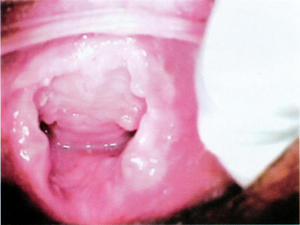Summary
Definition
History and exam
Key diagnostic factors
- disclosure of inappropriate contact
- acute or residual (healing) anogenital trauma (any change); evidence of hymenal trauma (in children)
- sexually transmitted infections
Other diagnostic factors
- normal genital findings
- emotional and psychological sequelae
- anogenital lesions
- nongenital injuries
- vaginal or penile discharge
- harmful behaviors
- sexual behavior problems in children
- chronic medical complaints in children
- frequent or persistent genitourinary complaints
- hymenal notches
Risk factors
- sexual abuse of other children in the home
- childhood exposure to intimate partner violence
- single-parent household
- adolescents and young women
- learning or physical disability
- mental health issues
- poverty or homelessness
- sex workers
- living in institutions or areas of conflict
- use of alcohol or other drugs
Diagnostic tests
1st tests to order
- forensic specimens
- testing for Neisseria gonorrhoeae
- testing for Chlamydia trachomatis
- serologic tests for syphilis
- serologic tests for hepatitis B
- HIV serology
- urine beta human chorionic gonadotropin
- testing for Trichomonas vaginalis
- anogenital culture: herpes simplex virus polymerase chain reaction (PCR)
- LFT
- creatinine
- BUN
- CBC
Tests to consider
- HIV confirmatory test
- HIV RNA PCR
- Treponema pallidum hemagglutination assay for syphilis
- serum rapid plasma reagin for syphilis
- serologic tests for hepatitis C
Treatment algorithm
≤72 hours since assault: prepubertal children
≤72 hours since assault: adolescent or adult
>72 hours since assault: prepubertal children
>72 hours since assault: adolescent or adult
Contributors
Authors
Sheela Lahoti, MD
Professor
Division of Child Safety and Integrated Care
Department of Pediatrics
University of Texas Medical School at Houston
Houston
TX
Disclosures
SL declares that she has no competing interests.
Rebecca Girardet, MD
Professor
Pediatrics Child Abuse Services
Department of Pediatrics
University of New Mexico
Albuquerque
NM
Disclosures
RG will likely provide expert testimony for a private firm in Albuquerque, NM, on a child sexual abuse civil case in 2025. RG is a member of the American Academy of Pediatrics Executive Committee on Child Abuse and Neglect. RG is the principal investigator for service grants from the New Mexico Crime Victims Reparation Commission that supports child sexual abuse programs at the University of New Mexico.
Simi Abraham, MD
Assistant Professor
Division of Child Safety and Integrated Care
Department of Pediatrics
University of Texas Medical School at Houston
Houston
TX
Disclosures
SA gives expert testimony in cases on this subject.
Michelle Ruda, MD
Associate Professor
Division of Child Safety and Integrated Care
Department of Pediatrics
University of Texas Medical School at Houston
Houston
TX
Disclosures
MR declares that she has no competing interests.
Margaret McNeese, MD
Professor
Division of Community and General Medicine
Department of Pediatrics
University of Texas Medical School at Houston
Houston
TX
Disclosures
MM declares that she has no competing interests.
Ashley Gibson, MD
Assistant Professor
Division of Child Safety and Integrated Care
Department of Pediatrics
UT Health Houston
Houston
TX
Disclosures
AG declares that she has no competing interests.
Arezo Nasrazadani, MD
Assistant Professor
Division of Child Safety and Integrated Care
Department of Pediatrics
UT Health Houston
Houston
TX
Disclosures
AN declares that she has no competing interests.
Acknowledgements
Dr Sheela Lahoti, Dr Rebecca Girardet, Dr Michelle Ruda, Dr Simi Abraham, Dr Margaret McNeese, Dr Ashley Gibson, and Dr Arezo Nasrazadani would like to gratefully acknowledge Dr Zoe O'Connor for her contribution to this topic, and Dr Christopher Greeley, Dr Shaina Goldsmith, and Dr Jan Welch, previous contributors to this topic.
Disclosures
CG, SG, and JW declare that they have no competing interests.
Peer reviewers
Cindy W. Christian, MD
Professor of Pediatrics
University of Pennsylvania
Perelman School of Medicine
Philadelphia
PA
Disclosures
CWC provides medical legal expertise in child abuse cases.
Christopher C. Stewart, MD
Professor of Pediatrics
University of California
San Francisco
CA
Disclosures
CCS declares that he has no competing interests.
Ruth Gilbert, MD, MSc, MB ChB
Professor of Clinical Epidemiology
UCL-Institute of Child Health
London
UK
Disclosures
RG declares that she has no competing interests.
References
Key articles
Workowski KA, Bachmann LH, Chan PA, et al; Centers for Disease Control and Prevention. Sexually transmitted infections treatment guidelines, 2021. MMWR Recomm Rep. 2021 Jul 23;70(4):1-187.Full text Abstract
British Association of Sexual Health and HIV. BASHH national guideline on the management of sexually transmitted infections and related conditions in children and young people. 2021 [internet publication].Full text
Reference articles
A full list of sources referenced in this topic is available to users with access to all of BMJ Best Practice.

Differentials
- Lichen sclerosus
- Urethral prolapse
- Nevus
More DifferentialsGuidelines
- Interpretation of medical findings in suspected child sexual abuse: an update for 2023
- Caring for patients who have experienced trauma
More GuidelinesPatient information
Chlamydia
Genital herpes
More Patient informationLog in or subscribe to access all of BMJ Best Practice
Use of this content is subject to our disclaimer